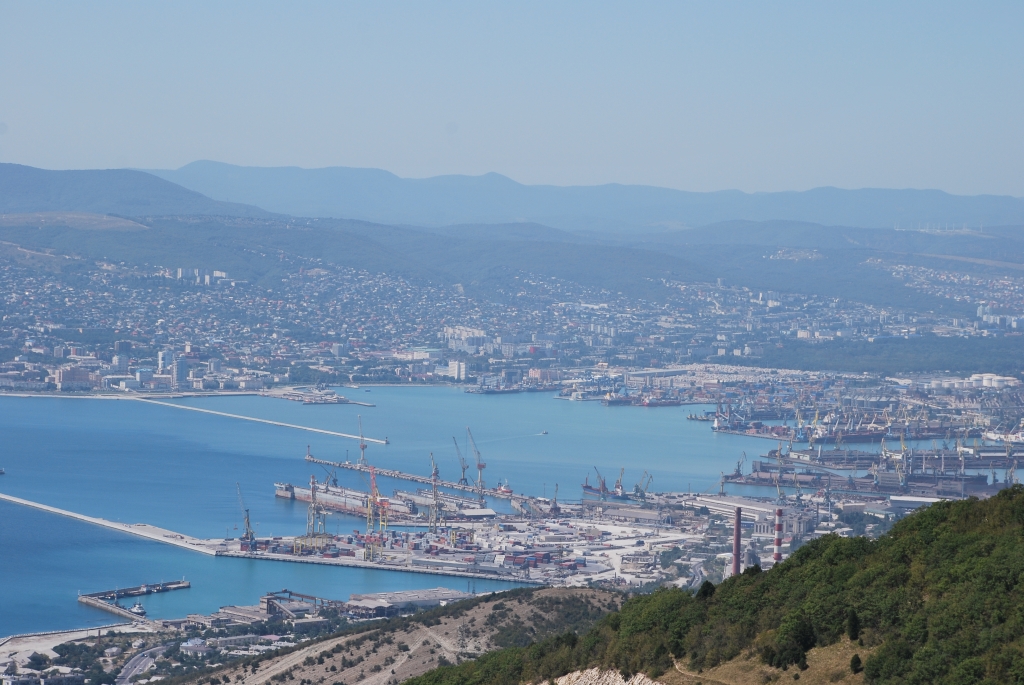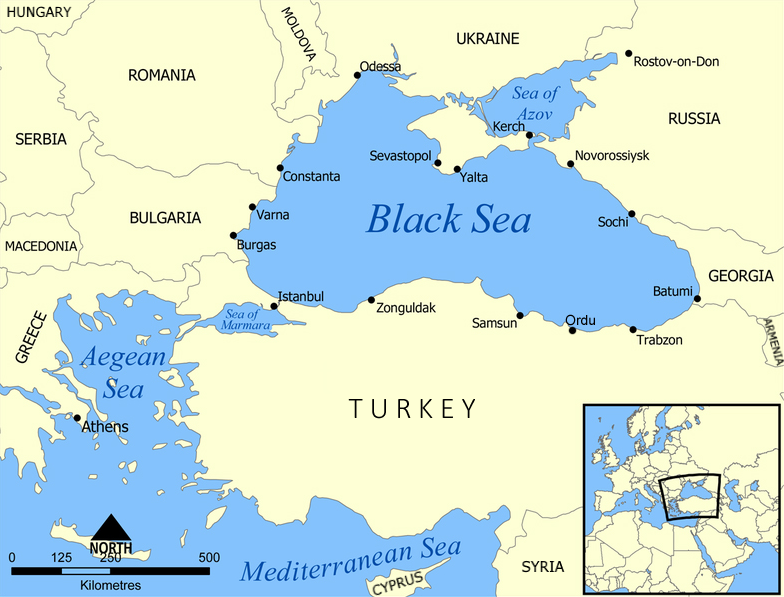|
North Caucasus Front
The North Caucasian Front or North Caucasus Front was a major formation of the Red Army during the Second World War. The North Caucasus Front describes either of two distinct organizations during the war. First Creation The first formation was created on May 20, 1942 and was commanded by Marshal Semyon M. Budenny throughout its existence. The Front incorporated forces from the (disbanded) Crimean Front and received additional forces from the (disbanded) Southern Front on July 28, 1942. The Front was composed of * 44th Soviet Army (Andrei Khryashchev and Ivan Yefimovich Petrov), * 47th Soviet Army ( Grigory Kotov), * 51st Soviet Army ( Nikolai Kirichenko and Trofim Kolomiets). The 1st Rifle Corps reappeared in the Soviet OOB on 1 June 1942, directly subordinated to the North Caucasus Front, and was made up of four rifle brigades. The North Caucasus Front at different times also included the 9th, 12th, 18th, 24th, 37th, 56th Army, 4th and 5th Air Army. The Front also ... [...More Info...] [...Related Items...] OR: [Wikipedia] [Google] [Baidu] |
Red Army Flag
Red is the color at the long wavelength end of the visible spectrum of light, next to orange and opposite violet. It has a dominant wavelength of approximately 625–740 nanometres. It is a primary color in the RGB color model and a secondary color (made from magenta and yellow) in the CMYK color model, and is the complementary color of cyan. Reds range from the brilliant yellow-tinged scarlet and vermillion to bluish-red crimson, and vary in shade from the pale red pink to the dark red burgundy. Red pigment made from ochre was one of the first colors used in prehistoric art. The Ancient Egyptians and Mayans colored their faces red in ceremonies; Roman generals had their bodies colored red to celebrate victories. It was also an important color in China, where it was used to color early pottery and later the gates and walls of palaces. In the Renaissance, the brilliant red costumes for the nobility and wealthy were dyed with kermes and cochineal. The 19th century brought ... [...More Info...] [...Related Items...] OR: [Wikipedia] [Google] [Baidu] |
Trofim Kolomiets
Trofim Kolomiets (1894 – April 1971) was a Soviet Army commander. Biography Kolomiets was born in Elisavetgrad, in the Kherson Governorate of the Russian Empire (present-day Ukraine). He fought in the Imperial Russian Army during World War I before joining the Red Army in the Russian Civil War. At the beginning of the Great Patriotic War, he was a major general. He fought against the forces of the Axis powers at Smolensk in 1941. He was then assigned in July 1941 to the defence of Crimea as deputy commander of the 51st Army, of which he became commander in July 1942 shortly after the defeat in the Battle of the Kerch Peninsula against Manstein's troops. The remnants of Kolomiets' army were evacuated to the Kuban and assigned to the North Caucasus Front and then, from 1 August 1942, to the southern flank of the Stalingrad Front, which became the Southern eastern front on 6 August 1942. Unable to stop the momentum of the 4th Panzer Army The 4th Panzer Army (german ... [...More Info...] [...Related Items...] OR: [Wikipedia] [Google] [Baidu] |
Krasnodar Krai
Krasnodar Krai (russian: Краснода́рский край, r=Krasnodarsky kray, p=krəsnɐˈdarskʲɪj kraj) is a federal subject of Russia (a krai), located in the North Caucasus region in Southern Russia and administratively a part of the Southern Federal District. Its administrative center is the city of Krasnodar. The third most populous federal subject, the krai had a population of 5,226,647 as of the 2010 Census. Krasnodar Krai is formally and informally referred to as Kuban (russian: Кубань), a term denoting the historical region of Kuban situated between the Sea of Azov and the Kuban River which is mostly composed of the krai's territory. It is bordered by Rostov Oblast to the north, Stavropol Krai to the east, Karachay-Cherkessia to the south-east, and Adygea is an enclave entirely within the krai. Krasnodar Krai shares an international border with the disputed region of Georgia, Abkhazia, to the south, and borders annexed Crimea to the west, acr ... [...More Info...] [...Related Items...] OR: [Wikipedia] [Google] [Baidu] |
Transcaucasian Front
Transcaucasian Front or Transcaucasus Front (russian: Закавказский Фронт) was a front of the Soviet Red Army—a military formation comparable to an army group, not a geographic military front—during the Second World War. The Transcaucasus Front describes two distinct organizations during the war. First creation The first version was created on 23 August 1941 from the Transcaucasus Military District, which was originally formed in 1922. The boundary of the Front extended along the Soviet border with Turkey and along the Black Sea coast from Batumi to Tuapse. It was commanded by Lieutenant-General Dmitry Kozlov from August 1941 to December 1941. On 22 June 1941, when the German invasion started, the Transcaucasus Military District included the 3rd, 24th, and 40th Rifle Corps, the 28th Mechanised Corps, two cavalry divisions (the 17th Mountain and the 24th) and three separate rifle divisions (the 63rd, 76th, and 77th). Also part of the District were ... [...More Info...] [...Related Items...] OR: [Wikipedia] [Google] [Baidu] |
Black Sea Group Of Forces
Black is a color which results from the absence or complete absorption of visible light. It is an achromatic color, without hue, like white and grey. It is often used symbolically or figuratively to represent darkness. Black and white have often been used to describe opposites such as good and evil, the Dark Ages versus Age of Enlightenment, and night versus day. Since the Middle Ages, black has been the symbolic color of solemnity and authority, and for this reason it is still commonly worn by judges and magistrates. Black was one of the first colors used by artists in Neolithic cave paintings. It was used in ancient Egypt and Greece as the color of the underworld. In the Roman Empire, it became the color of mourning, and over the centuries it was frequently associated with death, evil, witches, and magic. In the 14th century, it was worn by royalty, clergy, judges, and government officials in much of Europe. It became the color worn by English romantic poets, businessm ... [...More Info...] [...Related Items...] OR: [Wikipedia] [Google] [Baidu] |
Novorossiysk Defensive Operation
Novorossiysk ( rus, Новоросси́йск, p=nəvərɐˈsʲijsk; ady, ЦIэмэз, translit=Chəməz, p=t͡sʼɜmɜz) is a city in Krasnodar Krai, Russia. It is one of the largest ports on the Black Sea. It is one of the few cities honored with the title of the Hero City. Population: History In antiquity, the shores of the Tsemes Bay were the site of Bata ( el, Μπάτα), an ancient Greek colony that specialized in the grain trade. It is mentioned in the works of Strabo and Ptolemy, among others. Following brief periods of Roman and Khazar control, from the 9th century onwards, the area was part of the Byzantine θέμα Χερσῶνος ''Thema Khersonos'' (Province of Cherson). During the 11th century, the area was overrun and controlled by nomads from the Eurasian steppe, led by the Cumans. Later that century, the Byzantine emperor Ἀλέξιος Κομνηνός Alexios I Komnenos ( r. 1081–1118) was approached by Anglo-Saxon refugees, who had left Engl ... [...More Info...] [...Related Items...] OR: [Wikipedia] [Google] [Baidu] |
Krasnodar
Krasnodar (; rus, Краснода́р, p=krəsnɐˈdar; ady, Краснодар), formerly Yekaterinodar (until 1920), is the largest city and the administrative centre of Krasnodar Krai, Russia. The city stands on the Kuban River in southern Russia, with a population of 1,099,344 residents, and up to 1.2 million residents in the Urban Okrug. In the past decade Krasnodar has experienced rapid population growth, rising to become the thirteenth-largest city in Russia, and the second-largest city in southern Russia, as well as the Southern Federal District. The city originated in 1793 as a fortress built by the Cossacks, and became a trading center for southern Russia. The city sustained heavy damage in World War II but was rebuilt and renovated after the war. Krasnodar is a major economic hub in southern Russia; In 2012, ''Forbes'' named Krasnodar the best city for business in Russia. Krasnodar is home to numerous sights, including the Krasnodar Stadium. Its main airport is Kr ... [...More Info...] [...Related Items...] OR: [Wikipedia] [Google] [Baidu] |
Stavropol
Stavropol (; rus, Ставрополь, p=ˈstavrəpəlʲ) is a city and the administrative centre of Stavropol Krai, Russia. As of the 2021 Census, its population was 547,820, making it one of Russia's fastest growing cities. It was known as ''Voroshilovsk'' until January 12, 1943.Decree of January 12, 1943 Etymology The name ''Stavropol'' ( rus, Ста́врополь) is a Russian rendering of the Greek name, ( grc-gre, Σταυρούπολις 'City of the Cross'). According to legend, soldiers found a stone cross there while building the fortress in the city's future location. It is unrelated to Byzantine Stauroupolis (ancient Aphrodisias) in Asia Minor, nor to the city of Stavropol-on-Volga (now called Tolyatti). History It was founded on October 22, 1777Charter of Stavropol, Article 2 following the Russo-Turkish War of 1768–1774 as a military encampment, and was granted city status in 1785. Prince Grigory Potemkin, who founded Stavropol as on ... [...More Info...] [...Related Items...] OR: [Wikipedia] [Google] [Baidu] |
Siege Of Sevastopol (1941–1942)
A siege is a military blockade of a city, or fortress, with the intent of conquering by attrition, or a well-prepared assault. This derives from la, sedere, lit=to sit. Siege warfare is a form of constant, low-intensity conflict characterized by one party holding a strong, static, defensive position. Consequently, an opportunity for negotiation between combatants is common, as proximity and fluctuating advantage can encourage diplomacy. The art of conducting and resisting sieges is called siege warfare, siegecraft, or poliorcetics. A siege occurs when an attacker encounters a city or fortress that cannot be easily taken by a quick assault, and which refuses to surrender. Sieges involve surrounding the target to block the provision of supplies and the reinforcement or escape of troops (a tactic known as "investment"). This is typically coupled with attempts to reduce the fortifications by means of siege engines, artillery bombardment, mining (also known as sapping), or the us ... [...More Info...] [...Related Items...] OR: [Wikipedia] [Google] [Baidu] |
Azov Flotilla
The Azov Flotilla or Azov Naval Flotilla was the name given to several Russian naval forces operated on the Sea of Azov as part of the Imperial Russian Navy, by both the Soviets and the White Russians during the Russian Civil War, and as part of the Soviet Navy during World War II. Russo-Turkish War The flotilla was first formed in 1768 for the Russo-Turkish War (1768-1774) under the command of vice-admiral Alexei Senyavin. It was disbanded in 1783 and its ships handed over to the Black Sea Fleet. Russian civil war During the Russian Civil War, the Bolsheviks formed the flotilla in April 1918 to fight the Germans and the White Guards. As early as the end of June, the flotilla was destroyed after the coastline of the Azov Sea was lost, and the crews were transferred to the Red Army. After Denikin's defeat in March 1920, the Red Army recaptured the coast of the Sea of Azov, and the flotilla was formed again under the command of S.E. Markelov and based at Mariupol. All ships tha ... [...More Info...] [...Related Items...] OR: [Wikipedia] [Google] [Baidu] |




